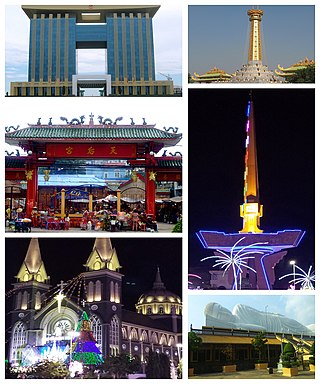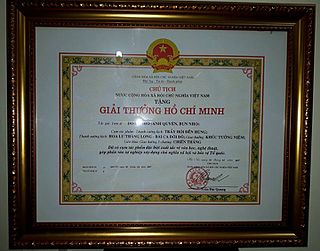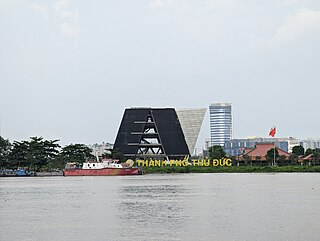Related Research Articles

Hanoi is the capital and second-most populous city of Vietnam. The name "Hanoi" translates to "inside the river," – Hanoi is bordered by the Red and Black Rivers. As a municipality, Hanoi consists of 12 urban districts, 17 rural districts, and one district-level town. The city encompasses an area of 3,359.84 km2 (1,297.24 sq mi) and as of 2023, a population of 8,587,100. Hanoi had the second-highest gross regional domestic product of all Vietnamese provinces and municipalities at 51.4 billion USD in 2022, behind Ho Chi Minh City.

Transportation in Vietnam is improving rapidly in terms of both quantity and quality. Road traffic is growing rapidly but the major roads are dangerous and slow to travel on due to outdated design and an inappropriate traffic mix. In recent years, the construction of expressways has accelerated. Air travel is also important for long-distance travel. Metro systems are under construction in the two metropolises of Hanoi and Ho Chi Minh City.

Kon Tum City is the capital city of Kon Tum Province in Vietnam. It is located inland in the Central Highlands region of Vietnam, near the borders of Laos and Cambodia.

Biên Hòa is the capital city of Đồng Nai Province, Vietnam, and is part of the Ho Chi Minh City metropolitan area. Situated northeast of Ho Chi Minh City, Biên Hòa is connected to it via National Route 1. As a class-1 provincial city, it is the sixth largest city in Vietnam by population.

Hải Dương is a city in Vietnam. It is the capital of Hải Dương, an industrialized province in the Hanoi Capital Region and the Red River Delta in Northern Vietnam. The city is at the midpoint between the capital Hanoi and the major port Haiphong, and is part of the Northern Key Economic Zone. In 2019, Hai Duong city had a population of 241,373.

Thủ Dầu Một is the capital city of Bình Dương province, Vietnam, located at around 10°58′0″N106°39′0″E. The city has an area of 118.91 km², with a population of 336.705, and is located 20 km north of downtown Ho Chi Minh City, on the left bank of the Saigon River, upstream from the city.

Hà Kiều Anh is a Vietnamese actress and former beauty queen.

Cầu Giấy is an urban district of Hanoi, the capital city of Vietnam. It is located roughly to the west of urban Hanoi. Cầu Giấy has a unique urban landscape, with new urban developments interlacing old historical artisan villages. The most well-known of them is a cluster of Dịch Vọng villages with its popular cốm dessert.

Ho Chi Minh City metropolitan area is a metropolitan area that was in June 2008 proposed by the Ministry of Construction of Vietnam to the Government of Vietnam for approval. According to this master plan, this metropolitan area will include provinces around Ho Chi Minh City in the Southeast region and 2 provinces in the Mekong Delta region.
The Ministry of Industry and Trade is the government ministry in Vietnam responsible for the advancement, promotion, governance, regulation, management and growth of industry and trade. The former Ministry of Trade has its origins in 1945 with the formation of the modern National Unification Cabinet, and became a ministry in its own right in 1955. The Ministry of Trade merged with the Ministry of Industry in 2007 to form the Ministry of Industry and trade. The current Minister of Industry and Trade is Nguyễn Hồng Diên. Ministry main offices are located in Hanoi.

The North–South Expressway East is an expressway in Vietnam located very close to National Route 1, acting as an artery traversing the entirety of Vietnam from North to South. Similar to National Route 1, the expressway starts from Lạng Sơn and ends at Cà Mau. At the northern border, the expressway will connect to Nanning-Youyiguan Expressway in China.

The Hồ Chí Minh Prize is an honorary award given by the government of Vietnam in recognition of cultural and/or scientific achievement. The prize was established by decree in 1981, and has been awarded in 1996, 2000, 2005 and 2012, often posthumously. The prize is named for Ho Chi Minh, who was Chairman and founder of the Workers' Party of Vietnam, that is considered one of the highest honors bestowed by Vietnam.
A municipal city, commonly known as a city within a city, is a type of second tier subdivision of Vietnam along with urban district, district, town and provincial city, all of which have equal status.

Thủ Đức is a municipal city (sub-city) under the administration of Ho Chi Minh City, Vietnam.

The seals of the Nguyễn dynasty can refer to a collection of seals specifically made for the emperors of the Nguyễn dynasty, who reigned over Vietnam between the years 1802 and 1945, or to seals produced during this period in Vietnamese history in general.

The 2022 V.League 1, known as the Night Wolf V.League 1 for sponsorship reasons, was the 39th season of the V.League 1, the highest division of Vietnamese football and the 22nd as a professional league. The season started on 25 February 2022, and ended on 20 November.

Linh Đàm is a neighborhood located in Hoàng Mai district, Hanoi. With a population of about 80,000 people, Linh Đàm is among the most densely populated neighborhoods in Vietnam. First settled in around the early 1600s, the area was mostly a swamp and sparsely-populated area until the early 1990s, when it was planned to relieve overpopulation in the urban core of Hanoi. The neighborhood is characterized by tall buildings and the Linh Đàm lake serving the community.
References
- ↑ "Đô thị loại I, II, III, IV, V và đô thị loại đặc biệt tại Việt Nam". thuvienphapluat.vn (in Vietnamese). April 21, 2022.
- ↑ "Report on the implementation of tasks in the first 6 months and the plan for the last 6 months of 2024 by the Ministry of Construction" (PDF). Ministry of Construction's Electronic Information Portal (in Vietnamese). 2024-07-09.
- ↑ "Resolution No. 1210/2016/UBTVQH13 on urban classification issued by the Standing Committee of the National Assembly" (in Vietnamese).
- ↑ See Nghị định số 123/2004/NĐ-CP and Nghị định số 124/2004/NĐ-CP
- ↑ Nhu, Mai (October 3, 2022). "Phân loại đô thị theo vùng miền và yếu tố đặc thù từ ngày 01/01/2023". thuvienphapluat.vn (in Vietnamese).